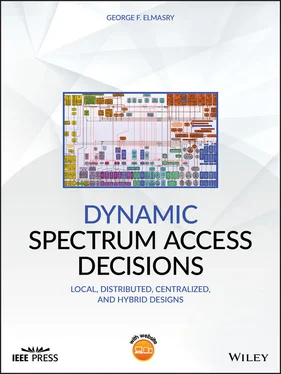The book is divided into four parts. The first two parts can be used as a textbook, with chapters including exercises. The first part represents digital communications theoretical bases and concept descriptions of DSA that can apply to any system. The second part includes some case studies for designing DSA capabilities as a set of cloud services. The second part does not cover every possible application that can use DSA, but these examples should be eye‐opening for any engineer who is looking to design DSA capable systems. The third part of the book includes the public domain publication of the US Army Techniques for Spectrum Management Operation , which provides excellent information on the US Army doctrine for spectrum management. The reader can see the involvement of the military domain use of DSA and see the challenges facing military applications of DSA. The fourth part is the established DySPAN standardization, also known as the IEEE P1900.
George F. Elmasry
3GPPthird‐generation partnership project4Gfourth generation5Gfifth generationACESautomated communications engineering softwareADCanalog to digital converterAESOPafloat electromagnetic spectrum operations programAJantijammingAMamplitude modulationAOCarea of coverageAPIapplication program interfaceAWGNadditive white Gaussian noiseBGPborder gateway protocolbpsbits per secondCBRSCitizens' Broadband Radio ServiceCEMAcyber electromagnetic activitiesCDMAcode division multiple accessCFARconstant false alarm rateCJCSMChairman of the Joint Chiefs of Staff manualCJSMPTCoalition Joint Spectrum Management Planning ToolCOAcourse of actionCOMSECcommunications securityCOPcommon operational pictureCROCcomplementary receiving operating characteristicsCSDFcyclic spectral density functionCSMAcarrier sense multiple accessCSVcomma separated valuesDADepartment of the ArmyDACdigital to analog converterDARPAdefense advanced research projects agentdBdecibellsdBmdecibells relative to 1 mWDDDepartment of DefenseDFdecision fusionDFCdecision fusion centerDFTdiscrete Fourier transformDLdown linkDLEPdynamic link exchange protocolDODDepartment of DefenseDSAdynamic spectrum access/dynamic spectrum awarenessDSMdynamic spectrum managementDTDdevice‐to‐deviceDTVdigital televisionDySPANdynamic spectrum access networkEAelectronic attackEEenergy efficiencyEMIelectromagnetic interferenceEMOEelectromagnetic operational environmentEPelectronic protectionEWelectronic warfareEWOelectronic warfare officerFCCfederal communications commissionFDfull duplexFDMAfrequency division multiple accessFECforward error correctionFFTfast Fourier transformationFSPLfree space path lossFTFourier transformG‐2assistant chief of staff for intelligenceG‐3assistant chief of staff, operationsG‐6assistant chief of staff, signalG‐7assistant chief of staff, information engagementGEMSISGlobal Electromagnetic Spectrum Information SystemGHzgigahertzGPPgeneral purpose processGPSglobal positioning systemHAPhigh altitude platformHERFhazards of electromagnetic radiation to fuelsHEROhazards of electromagnetic radiation to ordnanceHERPhazards of electromagnetic radion to personnelHFhigh frequencyHNhost nationHNSWDOHost Nation Spectrum Worldwide Database OnlineHzHertzIaaSinfrastructure as a serviceICDinterface control definitionIPinternet protocolIPSecinternet protocol securityJ‐3operations directorate of a joint staffJ‐6communications system directorate of a joint staffJACSjoint automated communications electronics operation instructions systemJCEOIjoint communications‐electronics operating instructionsJFMOjoint frequency management officeJRFLjoint restricted frequency listJSCjoint spectrum centerJSIRjoint spectrum interference resolutionJSIROjoint spectrum interference resolution onlineJSMEjoint spectrum management elementkHzkilohertzLBTlisten before talkLTElong‐term evolutionLPDlow probability of detectionLPIlow probability of interceptionMAmultiple accessMACmedium access controlMACmultiple access channelM‐AMM‐level amplitude modulationMANCATmultispectral ambient noise collection and analysis toolMANETmobile ad hoc networksMCEBMilitary Communications Electronics BoardMDMPmilitary decision‐making processMHzmegahertzMIMOmultiple‐input multiple‐outputMU MIMOmulti‐user MIMOmWmilliwattNCEnetwork‐centric environmentNGNational GuardNIPRNETNonsecure Internet Protocol Router NetworkNISTNational Institute of Standards and TechnologyNORMnack oriented reliable multicastNSAnational security agentNTIANational Telecommunicatoins and Information AdministrationOFDMAorthogonal frequency division multiple accessOPLANoperation planOPORDoperation orderOSIopen systems interconnectionOTAover‐the‐airOWAopen wireless architecturePACparallel access channelPDFprobability distribution functionPDFprobability density functionPPPOEpoint‐to‐point protocol over EthernetPSKphase shift keyingPUprimary userQAMquadrature amplitude modulationQoSquality of serviceR2Rrouter‐to‐radioRATradio access technologyRFradio frequencyROCreceiver's operator characteristicsRSReed‐SolomonRSSIreceived signal strength indicationS‐2battalion or brigade intelligence staff officerS‐3battalion or brigade operations staff officerS‐6(Army) battalion or brigade signal staff officerS2ASSpectrum Situational Awareness SystemSAspectrum awarenessSAspectrum agentSASspectrum access systemSDDspectrum dependent devicesSDNsoftware defined networkSDRsoftware defined radioSFAFstandard frequency action formatSIself‐interferenceSigIntsignal intelligenceSINCGARSsingle‐channel ground and airborne radio systemSINRsignal to interference plus noise ratioSIPRNETSECRET Internet Protocol Rourter NetworkSIRsignal to interference ratioSiSsignal in spaceSISOsingle‐input single‐outputSMOspectrum management operationsSNRsignal‐to‐noise ratioSNIRsignal‐to‐noise interference ratioSOIsignal operating instructionsSONself‐organized networkSPEEDsystems planning, enginnering, and evaluation deviceSSRFstandard spectrum resource formatSRWsoldier radio waveformSUsecondary userSWaPsize weight and powerTDMAtime division multiple accessTGPterrestrial geolocation protocolTOStype of servicetransectransmission securityTTItransmission time intervalUEuser equipmentUHFultra‐high frequencyULup linkUSUnited StatesVHFvery high frequencyWiFiwireless fidelity (the term is trademarked for the IEEE 11.x)WINNFwireless innovation forumWNWwideband networking waveformXGnext generationXMLextensible markup language
About the Companion Website
Don't forget to visit the companion website for this book: 
www.wiley.com/go/elmasry/dsad
There you will find valuable material designed to enhance your learning, including:
Solution Manual
Scan this QR code to visit the companion website

Part I DSA Basic Design Concept
This book targets the field of dynamic spectrum access (DSA), which can also be referred to as dynamic spectrum awareness, dynamic spectrum management (DSM), or cooperative spectrum management. The book does not attempt to explain or summarize what is already established in standardization efforts, such as the dynamic spectrum access network (DySPAN), also known as the Institute of Electrical and Electronics Engineers (IEEE) P1900, 1or the Wireless Innovation Forum (WINNF) Spectrum Access System (SAS). Rather, it's goal is to help engineers design the most suitable DSA approach for whatever wireless communications system is being built. DSA is needed for a wide range of civilian and military communications systems to dynamically optimize spectrum use. A form of DSA can be used for licensed and unlicensed spectrum bands in a wide variety of systems. DSA is presented in this book with a wider context than cognitive radios. There are many commercial and military communications systems that are not necessarily categorized as cognitive systems, but use these techniques to dynamically manage scarce spectrum resources. In today's ever‐increasing appetite for bandwidth, every extra Hertz a wireless system can use means an increased rate of transmission in bits per second (bps) over the air (OTA). Different types of communications systems are evolving to add incremental DSA capabilities. For example, military communications systems are moving towards DSA with a mixed use of new cognitive waveforms and legacy noncognitive waveforms.
Читать дальше














